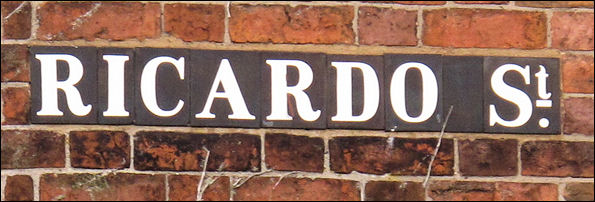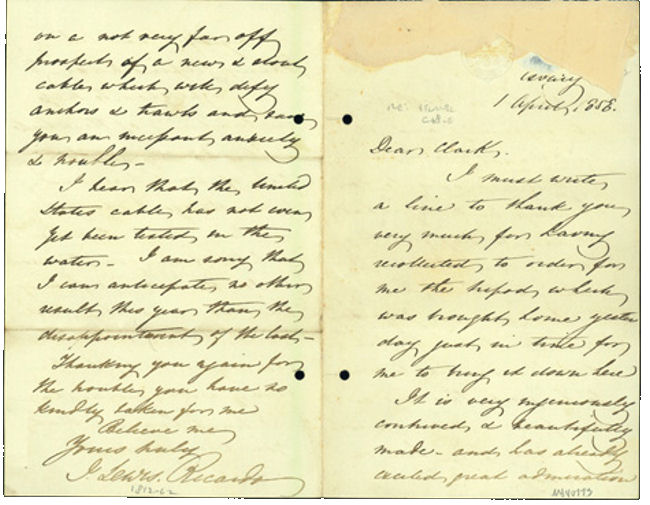![]() back to Portraits of Potteries People
back to Portraits of Potteries People
Biographies
of people from the Stoke-on-Trent &
Newcastle-under-Lyme Conurbations
John Lewis Ricardo
![]()
![]()
![]()
next: Jesse
Shirley - Flint & Bone Mill Owner
previous: Thomas Godwin - long distance cyclist
John Lewis Ricardo b.1812 d.1862
Entrepreneur, businessman and Liberal M.P. for Stoke-on-Trent
|

Ricardo
Street, Dresden, Longton was named after John Lewis Ricardo.
Many of the streets on this estate were named after leading liberals.
1845
- Ricardo
elected an M.P. for the Borough of Stoke-on-Trent
|
"Until the Reform Act of 1832 Newcastle had been the only town in the North Staffordshire area sending a Member to Parliament, but under this Act, the Parliamentary Borough of Stoke-on-Trent was permitted to send two members. The Wedgwood, Davenport, Heathcote, Copeland, Ricardo and other well known families all played active parts in the political life of the district.
John Lewis Ricardo, who became a forceful and prominent local Member of Parliament, was elected in 1845 and continued to represent the district until 1862." A Sociological History of Stoke-on-Trent - E.J.D. Warrillow |
1845 - Ricardo forms the Electric Telegraph Company


The Electric Telegraph
Company
Central Station, Founders’ Court, Lothbury, London
|
On September 3, 1845 a syndicate
led by the Ricardo family of City merchants projected a joint-stock
company to purchase all the patents Cooke and Wheatstone had obtained to
date and to provide capital for their more effective working,
particularly to gain an income from public messages through a national
network of telegraph lines.
This created The Electric Telegraph Company – the first joint-stock concern in the world intended to unite a country with a network of electric communications. It had a short life of just over twenty-five years. In that time it united electrically not just the entire country but also, with its corporate allies, reached the extremes of empire. The first Board of Directors of the Electric Telegraph Company comprised John Lewis Ricardo, the chairman, Samson Ricardo, brother and business partner of J L Ricardo, William Fothergill Cooke, George Parker Bidder and Richard Till. Distant Writing |
1846 - The North Staffordshire Railway Company was Incorporated
As
well as being Chairman of the Electric Telegraph Company for over
ten years Ricardo
was a director of the North Staffordshire Railway, the
Norwegian Trunk Railway,
the Metropolitan Railway and the London
& Westminster Bank.
| In the late 1830's the
railway station serving North Staffordshire was at Whitmore. In 1846 the
newly formed North Staffordshire Railway Company purchased part of
the Stoke Church glebe land known as Winton's Wood.
A new station designed in the Elizabethan & Jacobean style by H. A. Hunt of Parliament Street, London was built at a cost of £31,438. Stoke Railway Station and the complex at Winton Square was the most important building work undertaken by the railway company.
'The Railway Station
at Stoke, Staffordshire.' [Reproduced by
permission of the
To start the construction work, there was an official 'cutting of the first sod' ceremony. The site chosen for the ceremony was a field in Etruria. There was a roped - off enclosure for directors and the remainder of the field was reserved for invited guests. There was a mile long procession headed by John Lewis Ricardo, Member of Parliament for Stoke-on-Trent and chairman of the NSR Company. On his arrival, the crowds broke through the roped off area and Ricardo was pushed and shoved. During the actual cutting he buckled the silver spade and had difficulty removing the sod. Finally, his hat blew away. |

1923. 'L' Class Tank Engine. Built at Stoke-on-Trent.
Grace's Guide
|
The North Staffordshire Railway of Stoke-on-Trent was a British railway company which had its roots in an early scheme to build a small plateway from the base of the Cauldon Canal up to Cauldon Quarries. As well as the canals, other schemes were being promoted. The Staffordshire Potteries Railway promoted a route from Macclesfield to the mainline at Colwich plus a spur to Crewe and The Churnet valley scheme promoted a line from Macclesfield to Derby. After these two companies applied for the necessary powers to build the lines, Parliament suggested a pause of a year 'to afford time for consideration and for maturing some more complete scheme for the accommodation of that important district'. This was advantageous to the Staffordshire Potteries Railway who formed the North Staffordshire Railway company. 1846-1847 The company was incorporated by Acts of Parliament |
1858 - Ricardo discusses the trans-Atlantic cable

1858 letter from J. Lewis Ricardo where he talks about the recent attempts to lay a Trans-Atlantic cable

|
"Ricardo, the nephew of economist David Ricardo, founded the Electric Telegraph Company in 1846 together with William Fothergill Cooke; this was the world's first public telegraph company. In 1856 the Electric Telegraph Company merged with the International Telegraph Company, becoming the Electric and International Telegraph Company; Latimer Clark worked as an engineer for this company until its annexation by the British government in 1870. Ricardo's letter to Clark mentions the second attempt to lay the first Atlantic cable, which took place in June 1858. He also refers to the first unsuccessful attempt in 1857:
History of Science.com |
1862 - Obituary for John Lewis Ricardo
|
J. L. RICARDO, ESQ., M.P. Aug. 20. [1862] In Lowndes-square, aged 50, John Lewis Ricardo, Esq., M.P. for Stoke-upon-Trent. The deceased was the son of Mr. Jacob Ricardo, the financier, and nephew of David Ricardo, the political economist. He was born in 1812. He entered Parliament in 1841 as member for Stoke, which place he represented until his decease. He was one of the earliest advocates of free trade, in connection with Mr. C. P. Villier, and he aided materially in carrying the repeal of the Corn Laws. He made the Navigation Laws his particular study, and in 1847 he moved for a committee on the subject, and warmly supported the repeal of the restrictions on shipping.
But he is more particularly to be noticed for his public services in connection with the electric telegraph, concerning which we borrow the following statement from "The Electrician:"—
Among the improvements introduced in the system of the Telegraph Company by him, may be mentioned the plan of franks, or franked message papers, by which much time and trouble were saved to the public; and also the employment of female clerks, an innovation of considerable importance in a social point of view.
Mr. Ricardo was connected with many other important and useful
undertakings. He was Chairman of the North Staffordshire Railway, from its first construction to the time of his decease;
he was also Chairman of the Norwegian Trunk Railway, for the
construction of which, for the Norwegian Government, he had contracted jointly with Sir Morton Peto and Mr. Brassey. He was at one time Chairman of the Metropolitan Railway, and had been for many years a Director of the London and Westminster Bank.
Mr. Ricardo was a man of refined taste and a great lover of the arts. He possessed a particularly fine collection of water-colour drawings, and was himself no mean artist, having a remarkable talent for rapid and vigorous sketching.
In 1841 Mr. Ricardo married Lady Catherine, daughter of General the Hon. Sir Alexander Duff, of Dalgetty, Morayshire, and sister to the present Earl of Fife. He became possessed of considerable property in Morayshire through his wife, and had been one of the Deputy-lieutenants of that county since 1848.
John Lewis Ricardo Obituary, The Gentleman's Magazine (Oct. 1862) p. 496-7. |
![]()
![]()
![]()
next: Jesse
Shirley - Flint & Bone Mill Owner
previous: Thomas Godwin - long distance cyclist
|
Related pages.. Dresden & the Longton Freehold Land Society - A walk round the Dresden Estate showing how it came into existence in the middle of the 19th C and the development during the Victorian period. external pages.. David Ricardo on Wikipedia - Uncle of John Lewis Ricardo The history of The Electric Telegraph Company North Staffordshire Railway on Wikipedia |
|
Page created 26 February 2012 |